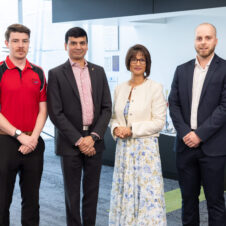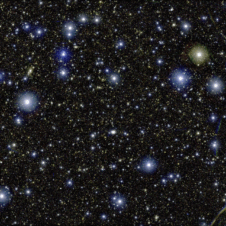Researchers may have answered a decades-old question about galaxy evolution, leveraging the power of artificial intelligence (AI) to accelerate their research.
Ever since the Hubble Sequence, that classifies galaxy morphologies, was invented in 1926, astronomers have been refining our understanding of galaxy evolution and morphology as our technology advances.
By the 1970’s, researchers had confirmed that lone galaxies tend to be spiral-shaped, and those found in clusters of galaxies were likely to be smooth and featureless, known as elliptical and lenticular (shaped like a lens).
Published today in the journal Monthly Notices of the Royal Astronomical Society, new research led by astronomers at the International Centre for Radio Astronomy Research (ICRAR) may have uncovered the reason for these differences in shapes.
Lead author Dr Joel Pfeffer from The University of Western Australia node of ICRAR, said the research explains the ‘morphology-density relation’ – where clustered galaxies appear smoother and more featureless than their solo counterparts.
“We’ve discovered there are a few different things going on when we get lots of galaxies packed together,” Dr Pfeffer said.
“The spiral arms on galaxies are so fragile, and as you go to higher densities in the galaxy clusters, spiral galaxies start to lose their gas.
“This loss of gas causes them to ‘drop’ their spiral arms, transforming into a lenticular shape.”
“Another cause is galaxy mergers, which can see two or more spiral galaxies crashing together to form one large elliptical galaxy in the aftermath.”

A visual representation of AI classifying galaxies based on data from the EAGLES simulation. Credit: ICRAR
The study utilised the powerful EAGLE simulations to analyse a group of galaxies in detail, using an AI algorithm to classify galaxies by their shape.
The neural network-based algorithm was trained by ICRAR PhD candidate Mitchell Cavanagh and can classify almost 20,000 galaxies per minute, compressing what would typically take weeks into one hour.
The simulations closely match what has been observed in the Universe, giving researchers the confidence to use the simulation results to interpret observations of galaxy clusters
The study also identified several lenticular galaxies outside of the high-density regions where they are expected, with the modelling suggesting they were created by the merging of two galaxies.
Dr Pfeffer said the work brings together various pieces of research in galactic evolution, to understand the morphology-density relation for the first time.
“There’s been lots of suggestions over time,” he said. “But this is the first work to really put all of pieces of the puzzle together.”
PUBLICATIONS
https://academic.oup.com/mnras/article/518/4/5260/6891783
‘The galaxy morphology-density relation in the EAGLE simulation, published in Monthly Notices of the Royal Astronomical Society on December 16, 2022.’
MORE INFORMATION
ICRAR
The International Centre for Radio Astronomy Research (ICRAR) is a joint venture between Curtin University and The University of Western Australia with support and funding from the State Government of Western Australia.
The Eagle Simulation
EAGLE (Evolution and Assembly of GaLaxies and their Environments) is a simulation aimed at understanding how galaxies form and evolve. This simulation is one of the largest cosmological hydrodynamical simulations ever, using nearly 7 billion particles to model the physics. It took more than one and a half months of computer time on 4000 compute cores of the DiRAC-2 supercomputer in Durham.

